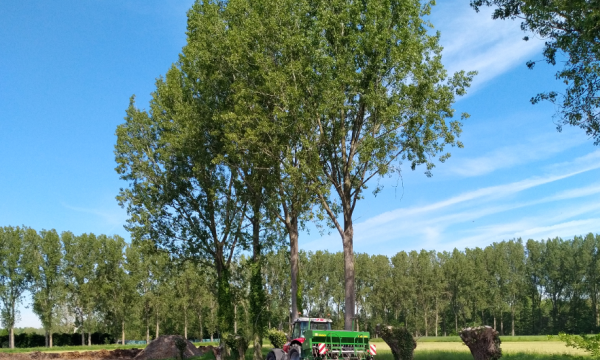Blog ILVO BLOGS from the Experimental Platform for Agroecology in Hansbeke: Mulching against weeds and dryness

By applying mulch to your soil, can you reduce or prevent drought stress in your crops? On June 1, 2021, the partners of the Experimental Platform for Agroecology in Hansbeke started a mulch test: The mulch was partly applied before sowing of the mixed corn-bean crop, and partly after sowing. Each time, no mulch was placed on half of the plot, in order to make a comparison. Our preliminary observation? The application of mulch is complex. Weather conditions play a major role in the effect and more research is needed.
A mulch layer is thought to have the following benefits:
- Weeds get less of a chance to develop
- The soil dries out less quickly
- The mulch provides extra nutrition for the soil life and the crop
Possible bottlenecks:
- Sowing through the mulch layer
- Equal application of the mulch
- Mixing the topsoil with the mulch during sowing
- Crop developmentg
Composition of the mulch
"Our original plan was to mulch with fresh grass clippings, the first cut of a grass-clover field sowed in fall of 2020. Due to soil conditions that were too wet when the cut became available, the clippings were mixed through a layer of wood chips on May 18, 2021, using PCG's Ménart compost turner to prevent rotting. For homogenization, the heap was turned a second time on May 27.”
Spreading and volume
The mulch was spread on June 1, 2021. We noticed a volume reduction due to pre-composting and storage. The mulch mix had more compact properties. An average layer thickness of up to (only) +-4 cm was targeted. Assuming fresh grass clover, the mulch layer might have had a more optimal thickness of +-10 cm.

Application of the mulch
Due to the small amount of mulch, it was not easy to apply it evenly with a manure spreader. In most places in the field a thickness of +-4 cm was achieved in a few places 6 cm.
Moisture in the soil
Due to the very wet weather conditions after sowing, the possible benefit of avoiding drought stress by maintaining soil moisture was not established at all. Also, the wet weather caused an accelerated breakdown of the mulch layer.
Keeping the mulch in place during sowing depends on the machinery used
There are seed drills that are able to deposit the seeds in the furrow through a layer of mulch. In this test, Sky EasyDrill and SimTech T-Sem machines were used. The results differed: Due to the disturbance of the mulch layer during overseeding, it was no longer contiguous everywhere and soil was deposited on the surface. Only in a part of the field where the mulch layer was a bit thicker (+-6 cm) and where sowing was done with the overseeder Sky EasyDrill, the mulch layer remained nicely intact. A mulch layer that is kept dense is important to prevent evaporation of soil moisture everywhere in times of drought.
Differences in crop development
The crop developed better on the non-mulched part. When mulched, plant density and initial development was best where mulch was applied after sowing. A factor that also contributed to this was the seeding technique, especially the use of a test field machine when mulching after seeding. The inhibition of crop development when mulching was applied was possibly related to some nitrogen starvation due to decomposition of the mulch by the wet weather (the microorganisms responsible for decomposition use a certain amount of nitrogen making less nitrogen available to the plant). The mulch was applied to avoid drought stress. In dry conditions, the mulch interacts with the soil to a lesser extent.
Weed suppression
Mulching reduced weed pressure. However, mixing the soil layer with the mulch, when sowing after mulching, brought weed seeds to the surface, resulting in less weed suppression than when sowing before mulching. At a thickness of 6 cm and sowing with the Sky EasyDrill machine, weed pressure was lowest, but so was plant density of the main crop. In the part of the plot where no mulch was applied, weeds were adequately controlled by two weeding sessions and one hoeing session. In that case, we see a far higher number of passes needed.
| Mulch | No mulch |
|---|---|
Sky EasyDrill overseeder, sowing after mulch, 2x weeding |
Sky EasyDrill overseeder, 2x weeding |
SimTech overseeder, sowing after mulch, 2x weeding |
SimTech doorzaaimachine, 2x weeding |
Trial field seed drill, sowing before mulch |
Proefveldzaaimachine, 2x weeding + 1x hoeing |

Mulch application is complex
The application of mulch is labor intensive and even application is not easy to achieve. It is also not yet clear which materials are suitable for mulching in all conditions. The weather influences the desirability and effectiveness of the measure. The application of mulch also implies a fairly high dosage of nutrients. This too must fit within the rotation and should not lead to nutrient surpluses or losses. More research is therefore needed.
Also read our blog post about sowing through mulch.
The Experimental Platform for Agroecology in Hansbeke is a collaboration between ILVO, PHAE and RHEA. The 50 ha of organic fields offers a unique experimentation space for agroecological principles. We regularly blog about these experiments via the ILVO website and social media.


